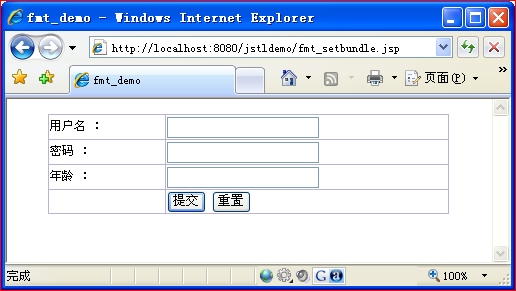国际标签(二)
国际标签(二)
一、动态数据的国际化
数值,货币,时间,日期等数据由于可能在程序运行时动态产生,所以无法像文字一样简单地将它们从应用程序中分离出来,而是需要特殊处理。Java 中提供了解决这些问题的 API 类(位于 java.util 包和 java.text 包中)
1、Locale 类
Locale 实例对象代表一个特定的地理,政治、文化区域。
一个 Locale 对象本身不会验证它代表的语言和国家地区信息是否正确,只是向本地敏感的类提供国家地区信息,与国际化相关的格式化和解析任务由本地敏感的类去完成。(若JDK中的某个类在运行时需要根据 Locale 对象来调整其功能,这个类就称为本地敏感类)
与前面的Core标签一样,在使用标签前需要先导入标签库,在JSP页面中导入国际化标签库的语法如下:
<%@ taglib uri=" http://java.sun.com/jsp/jstl/fmt" prefix="fmt"%>
二、几种主要的国际化标签
在JSTL之中的国际化标签主要包括<fmt:setLocale>、<fmt:bundle>、<fmt:setBundle>、<fmt:message>、<fmt:setLocale>:指定Locale环境。
<fmt:bundle>:指定消息资源使用的文件。
<fmt:setBundle>:设置消息资源文件。
<fmt:message>:显示消息资源文件中指定key的消息,支持带参数消息。
1、<fmt:setLocale>
<fmt:setLocale>标签用于在JSP页面中显式地设置用户的本地化信息,并将设置的本地化信息以Locale对象的形式保存在某个Web域中,其在Web域中的属性名称为“javax.servlet.jsp.jstl.fmt.locale”。使用<fmt:setLocale>标签设置本地化信息后,国际化标签库中的其他标签将使用该本地化信息,而忽略客户端浏览器传递过来的本地信息。
<fmt:setLocale value="locale"
[variant="variant"]
[scope="{page|request|session|application}"] />
<fmt:setBundle>
<fmt:setBundle>标签用于根据<fmt:setLocale>标签设置的本地化信息创建一个资源包(ResourceBundle)实例对象,并将其绑定到一个Web域的属性上。
标签的语法格式如下:
<fmt:setBundle basename="basename"
[var="varName"]
[scope="{page|request|session|application}"] />
2、<fmt:bundle>标签
<fmt:bundle>标签与<fmt:setBundle>标签的功能类似,但它创建的ResourceBundle实例对象只在其标签体内有效。
<fmt:bundle basename="basename“ >
body content
</fmt:bundle>
3、<fmt:message>标签
<fmt:message>标签用于从一个资源包中读取信息并进行格式化输出。
<fmt:message key="messageKey"
[bundle="resourceBundle"]
[var="varName"] [scope="{page|request|session|application}"] />
实例:
<%@ page language="java" import="java.util.*" pageEncoding="UTF-8"%>
<%@ taglib uri="http://java.sun.com/jsp/jstl/fmt" prefix="fmt" %>
<html>
<head>
<title>My JSP '5.jsp' starting page</title>
</head>
<fmt:setLocale value="en"/>
<fmt:setBundle basename="com.hbsi.resource.propertities.Myproperties"/>
<body>
<marquee behavior="scroll">
<font size="8" color="red">提交表单</font>
</marquee>
<form>
<table border="1px" align="center">
<tr>
<td><fmt:message key="userName"/></td>
<td><input type="text" name="username"/></td>
</tr>
<tr>
<td><fmt:message key="passWord"/></td>
<td><input type="password" name="password"/></td>
</tr>
<tr>
<td><fmt:message key="age"/></td>
<td><input type="password" name="age"/></td>
</tr>
<tr align="center">
<td colspan="2">
<input type="submit" value="<fmt:message key="submit"/>">
<input type="reset" value="<fmt:message key="reset"/>">
</td>
</tr>
</table>
</form>
</body>
</html>

三、国际化标签示例
实现页面的国际化效果需要按以下步骤进行。
创建页面需要的资源文件labels_en.properties、labels_zh.properties
将资源文件内容转码。
创建页面文件。
将labels_en.properties、labels_zh_CN.properties两个文件存放在项目的src目录下。新建名为fmt_setbundle.jsp的页面。
实现国际化效果还可以使用<fmt:bundle>标签,通过以下步骤可以完成此效果。
修改页面文件。
设置语言选项。执行“开始”→“程序”中的“Internet Explorer”命令,打开IE浏览器,选择“工具”→“浏览器选项”菜单命令,在弹出的“Internet选项”对话框中单击“语言”按钮,修改语言的首选项。
启动容器。启动Tomcat,输入“http://localhost:8080/jstldemo/fmt_ setbundle.jsp”,如果设置的语言的首选项为英语,则显示英文版的页面,如果首选语言为中文,则显示中文页面。
四、DateFormat类(国际化日期)
DateFormat 类可以将一个日期/时间对象格式化为表示某个国家地区的日期/时间字符串。
DateFormat 类除了可按国家地区格式化输出日期外,它还定义了一些用于描述日期/时间的显示模式的 int 型的常量,包括FULL, LONG, MEDIUM, DEFAULT, SHORT,实例化DateFormat对象时,可以使用这些常量,控制日期/时间的显示长度。
五、DateFormat类
例如,对于日期/时间“2005年9月15日下午4时41分20秒”,如设置了DateFormat的显示模式,则日期/时间显示样式分别为:
SHORT模式完全是数字的,在中文环境下显示为“05-9-15 下午4:41”;在英文环境下为“9/15/05 4:41 PM”。
MEDIUM模式比SHORT模式长些,在中文环境显示为“2005-9-15 16:41:20”;在英文环境下显示为“Sep 15, 2005 4:41:20 PM”。
LONG模式比MEDIUM模式更长一些,在中文环境下显示为“2005年9月15日 下午04时41分20秒”;在英文环境下显示为“September 15, 2005 4:41:20 PM CST”。
FULL模式指定日期/时间的完整格式,在中文环境下显示为“2005年9月15日 星期四 下午04时41分20秒 CST”;在英文环境下,这个日期/时间显示为“Thursday, September 15, 2005 4:41:20 PM CST”。
六、实例化DateFormat类
实例化DateFormat类有九种方式,以下三种为带参形式,下面列出的三种方式也可以分别不带参,或只带显示样式的参数。
getDateInstance(int style, Locale aLocale):以指定的日期显示模式和本地信息来获得DateFormat实例对象,该实例对象不处理时间值部分。
getTimeInstance(int style, Locale aLocale):以指定的时间显示模式和本地信息来获得DateFormat实例对象,该实例对象不处理日期值部分。
getDateTimeInstance(int dateStyle, int timeStyle, Locale aLocale):以单独指定的日期显示模式、时间显示模式和本地信息来获得DateFormat实例对象。
七、DateFormat类
DateFormat 对象的方法:
format: 将date对象格式化为符合某个本地环境习惯的字符串。
parse:将字符串解析为日期/时间对象
注意:parse和format完全相反,一个是把date时间转化为相应地区和国家的显示样式,一个是把相应地区的时间日期转化成date对象,该方法在使用时,解析的时间或日期要符合指定的国家、地区格式,否则会抛异常。
DateFormat 对象通常不是线程安全的,每个线程都应该创建自己的 DateFormat 实例对象
八、NumberFormat类
NumberFormat 可以将一个数值格式化为符合某个国家地区习惯的数值字符串,也可以将符合某个国家地区习惯的数值字符串解析为对应的数值
NumberFormat 类的方法:
format 方法:将一个数值格式化为符合某个国家地区习惯的数值字符串
parse 方法:将符合某个国家地区习惯的数值字符串解析为对应的数值。
实例化NumberFormat类时,可以使用locale对象作为参数,也可以不使用,下面列出的是使用参数的。
getNumberInstance(Locale locale):以参数locale对象所标识的本地信息来获得具有多种用途的NumberFormat实例对象
getIntegerInstance(Locale locale):以参数locale对象所标识的本地信息来获得处理整数的NumberFormat实例对象
getCurrencyInstance(Locale locale):以参数locale对象所标识的本地信息来获得处理货币的NumberFormat实例对象
getPercentInstance(Locale locale):以参数locale对象所标识的本地信息来获得处理百分比数值的NumberFormat实例对象
小练习:
package com.hbsi.demo;
import java.text.DateFormat;
import java.text.NumberFormat;
import java.text.ParseException;
import java.util.Date;
import java.util.Locale;
/* 1.请创建一个date对象,并把date对象中表示日期部分的时间值,以及表示时间部分的时间值,
* 分别以short、long模式进行格式化输出(国家设置为中国)。
2. 请将时间值:09-11-28 上午10时25分39秒 CST,反向解析成一个date对象。
4.动态文本国际化,课上的实例做一遍。
3. 请将整数198,输出为货币形式:$198,并将$198反向解析成整数198。
*/
public class Demo5 {
public static void main(String[] args) throws ParseException {
Demo5 d=new Demo5();
d.test1();
d.test2();
d.test3();
d.test4();
}
public void test1(){
//.请创建一个date对象,并把date对象中表示日期部分的时间值,以及表示时间部分的时间值,分别以short
Date date=new Date();
DateFormat df=DateFormat.getDateInstance(DateFormat.SHORT,Locale.CHINA);
String result=df.format(date);
System.out.println("short模式:"+result);
//请创建一个date对象,并把date对象中表示日期部分的时间值,以及表示时间部分的时间值,long模式进行格式化输出(国家设置为中国)。
Date date1=new Date();
DateFormat df1=DateFormat.getDateInstance(DateFormat.LONG,Locale.CHINA);
String result1=df1.format(date1);
System.out.println("long模式:"+result1);
}
public void test2(){
//请将时间值:09-11-28 上午10时25分39秒 CST,反向解析成一个date对象。
String s="09-11-28 上午10时25分39秒 CST";
DateFormat df=DateFormat.getDateInstance(DateFormat.MEDIUM,Locale.CHINA);
try {
Date d=df.parse(s);
System.out.println(d);
} catch (ParseException e) {
e.printStackTrace();
}
}
public void test3(){
// 请将整数198,输出为货币形式:$198,
int price=198;
NumberFormat nf=NumberFormat.getCurrencyInstance(Locale.US);
String str=nf.format(price);
System.out.println(str);
}
public void test4() throws ParseException{
//并将$198反向解析成整数198。
String price="$198";
NumberFormat nf=NumberFormat.getCurrencyInstance(Locale.US);
Number num=nf.parse(price);
System.out.println(num.doubleValue());
}
}
九、 <fmt:formatDate>标签
<fmt:formatDate>标签用于对日期和时间按本地化信息进行格式化,或对日期和时间按化为JSP页面作者自定义的格式进行格式化。语法格式如下:
<fmt:formatDate value="date"
[type="{time|date|both}"] [dateStyle="{default|short|medium|long|full}"] [timeStyle="{default|short|medium|long|full}"] [pattern="customPattern"]
[timeZone="timeZone"]
[var="varName"]
[scope="{page|request|session|application}"] />
十、<fmt:parseDate>标签
<fmt:parseDate>标签与<fmt: formatDate >标签的作用正好相反,它用于将一个表示日期和时间的字符串解析成java.util.Date实例对象.
语法1,没有标签体的情况:
<fmt:parseDate value="dateString"
[type="time|date|both"]
[dateStyle="default|short|medium|long|full"]
[timeStyle="default|short|medium|long|full"]
[pattern="customPattern"]
[timeZone="timeZone"]
[parseLocale="parseLocale"]
[var="varName"]
[scope="{page|request|session|application}"] />
十一、<fmt:formatNumber>标签
<fmt:formatNumber>标签用于将数值、货币或百分数按本地化信息进行格式化,或者按JSP页面作者自定义的格式进行格式化。
没有标签体的情况:
<fmt:formatNumber value="numericValue"
[type="{number|currency|percent}"]
[pattern="customPattern"]
[currencyCode="currencyCode"]
[currencySymbol="currencySymbol"]
[groupingUsed="{true|false}"]
[maxIntegerDigits="maxIntegerDigits"]
[minIntegerDigits="minIntegerDigits"]
[maxFractionDigits="maxFractionDigits"]
[minFractionDigits="minFractionDigits"]
[var="varName"]
[scope="{page|request|session|application}"] />
十二、<fmt:parseNumber>标签
<fmt:parseDate>标签与<fmt: formatNumber >标签的作用正好相反,它用于将一个按本地化方式被格式化后的数值、货币或百分数解析为数值
语法1,没有标签体的情况:
<fmt:parseNumber value="numericValue"
[type="{number|currency|percent}"]
[pattern="customPattern"]
[parseLocale="parseLocale"]
[integerOnly="{true|false}"]
[var="varName"
[scope="{page|request|session|application}"] />
语法2, 有标签体的情况,在标签体中指定要被解析的日期和/或时间值:
<fmt:parseDate [type="time|date|both"] [dateStyle="default|short|medium|long|full"] [timeStyle="default|short|medium|long|full"]
[pattern="customPattern"]
[timeZone="timeZone"]
[parseLocale="parseLocale"]
[var="varName"] [scope="{page|request|session|application}"]>
date value to be parsed
</fmt:parseDate>
十三、MessageFormat(动态文本)
如果一个字符串中包含了多个与国际化相关的数据,可以使用MessageFormat类对这些数据进行批量处理。
例如:
At 12:30 pm on jul 3,1998, a hurricance destroyed 99 houses and caused $1000000 of damage
以上字符串中包含了时间、数字、货币等多个与国际化相关的数据,对于这种字符串,可以使用MessageFormat类对其国际化相关的数据进行批量处理。
MessageFormat 类如何进行批量处理呢?
1.MessageFormat类允许开发人员用占位符替换掉字符串中的敏感数据(即国际化相关的数据)。
2.MessageFormat类在格式化输出包含占位符的文本时,messageFormat类可以接收一个参数数组,以替换文本中的每一个占位符。
十四、模式字符串与占位符
At 12:30 pm on jul 3,1998, a hurricance destroyed 99 houses and caused $1000000 of damage
模式字符串:
At {0} on {1},a destroyed {2} houses and caused {3} of damage.
|-----{占位符}
十五、格式化模式字符串
模式字符串:
On {0}, a hurricance destroyed {1} houses and caused {2} of damage.
MessageFormat类
MessageFormat(String pattern)
实例化MessageFormat对象,并装载相应的模式字符串。
format(object obj[])
格式化输出模式字符串,参数数组中指定占位符相应的替换对象。
format(new Object[ ]{date, new Integer(99), new Double(1E7) })
String pattern = "On {0}, a hurricance destroyed {1} houses and caused "
+ "{2} of damage.";
MessageFormat msgFmt = new MessageFormat(pattern,Locale.US);
//准备参数数组
String datetime = "Jul 3, 1998 12:30 PM";
Date date = DateFormat.getDateTimeInstance(DateFormat.MEDIUM,
DateFormat.SHORT, Locale.US).parse(datetime);
Object [] msgArgs = {date, new Integer(99),new Double(1E7)};
//执行格式化操作
String result = msgFmt.format(msgArgs);
System.out.println(result);
十六、模式字符串与占位符
占位符有三种方式书写方式:
{argumentIndex}: 0-9 之间的数字,表示要格式化对象数据在参数数组中的索引号
{argumentIndex,formatType}: 参数的格式化类型
{argumentIndex,formatType,FormatStyle}: 格式化的样式,它的值必须是与格式化类型相匹配的合法模式、或表示合法模式的字符串。
String pattern = "At {0, time, short} on {0, date}, a destroyed'\n'"
+ "{1} houses and caused {2, number, currency} of damage.";
MessageFormat msgFmt = new MessageFormat(pattern,Locale.US);
String datetimeString = "Jul 3, 1998 12:30 PM";
Date date = DateFormat.getDateTimeInstance(DateFormat.MEDIUM,
DateFormat.SHORT,Locale.US).parse(datetimeString);
String event = "a hurricance";
Object []msgArgs = {date, event, new Integer(99), new Double(1E7)};
String result = msgFmt.format(msgArgs);
System.out.println(result);
十七、<fmt:param>标签
<fmt:param>标签用于为格式化文本串中的占位符设置参数值,它只能嵌套在<fmt:message>标签内使用。
语法1,用value属性指定参数值:
<fmt:param value="messageParameter" />
语法2,在标签体中指定参数的值的情况:
<fmt:param>
body content
</fmt:param>